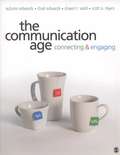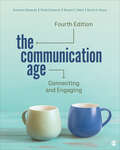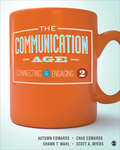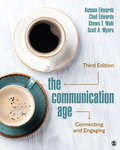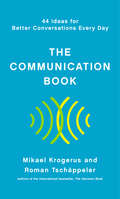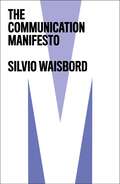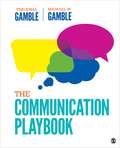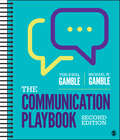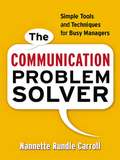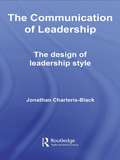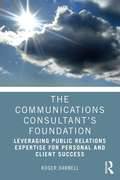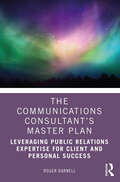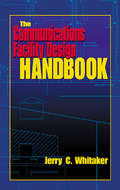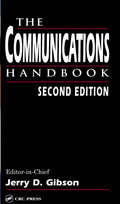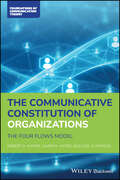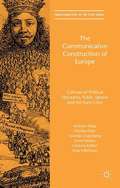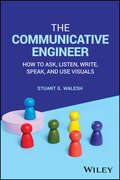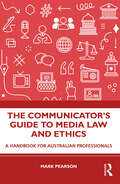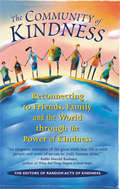- Table View
- List View
The Communication Age: Connecting and Engaging
by Autumn Edwards Chad Edwards Shawn T. Wahl Scott A. MyersNo matter who you are or how you communicate―from baby boomers to millenials, born digital or getting there―we are all members of a society who connect through the internet, not just to it. From face-to-face to facebook, this book by Autumn Edwards, Chad Edwards, Shawn T. Wahl, and Scott A. Myers invites you to join the conversation about today's issues and have your voice heard.
The Communication Age: Connecting and Engaging
by Autumn Edwards Shawn T. Wahl Scott A. Myers Chad C. EdwardsWhen should you send a text message, and when is it more appropriate to talk face-to-face? What is the best way to prepare for a job interview that will be conducted over video? How should you modify your speech if it will be recorded and posted online? The Communication Age: Connecting and Engaging introduces students to the foundational concepts and essential skills of effective communication, with a strong emphasis on the impact of technology in our increasingly interconnected world. This new Fourth Edition helps students become involved in our diverse global community and learn how to apply key principles of effective communication—whether incorporating media, technology, or traditional face-to-face speech communication—to foster civic engagement for a better future. With comprehensive coverage of the essentials of interpersonal, small group, and public communication, this text is ideal for use in hybrid introduction to communication courses.
The Communication Age: Connecting and Engaging
by Autumn Edwards Shawn T. Wahl Scott A. Myers Chad C. EdwardsWhen should you send a text message, and when is it more appropriate to talk face-to-face? What is the best way to prepare for a job interview that will be conducted over video? How should you modify your speech if it will be recorded and posted online? The Communication Age: Connecting and Engaging introduces students to the foundational concepts and essential skills of effective communication, with a strong emphasis on the impact of technology in our increasingly interconnected world. This new Fourth Edition helps students become involved in our diverse global community and learn how to apply key principles of effective communication—whether incorporating media, technology, or traditional face-to-face speech communication—to foster civic engagement for a better future. With comprehensive coverage of the essentials of interpersonal, small group, and public communication, this text is ideal for use in hybrid introduction to communication courses.
The Communication Age: Connecting and Engaging
by Dr Shawn T. Wahl Dr Chad C. Edwards Dr Scott A. Myers Dr Autumn EdwardsWe are in “the communication age.” No matter who you are or how you communicate, we are all members of a society who connect through the internet, not just to it. From face-to-face interactions to all forms of social media, The Communication Age, Second Edition invites you to join the conversation about today’s issues and make your voice heard. This contemporary and engaging text introduces students to the essentials of interpersonal, small group, and public communication while incorporating technology, media, and speech communication to foster civic engagement for a better future.
The Communication Age: Connecting and Engaging
by Dr Shawn T. Wahl Dr Chad C. Edwards Dr Scott A. Myers Dr Autumn EdwardsWhen should you send a text message, and when is it more appropriate to talk face-to-face? What is the best way to prepare for a job interview that will be conducted over video? How should you modify your speech if it will be recorded and posted online? The Communication Age: Connecting and Engaging by Autumn Edwards, Chad Edwards, Shawn T. Wahl, and Scott A. Myers introduces students to the foundational concepts and essential skills of effective communication, with a strong emphasis on the impact of technology in our increasingly interconnected world. This new Third Edition helps students become involved in our diverse global community and learn how to apply key principles of effective communication—whether incorporating media, technology, or traditional face-to-face speech communication—to foster civic engagement for a better future. With comprehensive coverage of the essentials of interpersonal, small group, and public communication, this text is ideal for use in hybrid introduction to communication courses.
The Communication Age: Connecting and Engaging
by Dr Shawn T. Wahl Dr Chad C. Edwards Dr Scott A. Myers Dr Autumn EdwardsWhen should you send a text message, and when is it more appropriate to talk face-to-face? What is the best way to prepare for a job interview that will be conducted over video? How should you modify your speech if it will be recorded and posted online? The Communication Age: Connecting and Engaging by Autumn Edwards, Chad Edwards, Shawn T. Wahl, and Scott A. Myers introduces students to the foundational concepts and essential skills of effective communication, with a strong emphasis on the impact of technology in our increasingly interconnected world. This new Third Edition helps students become involved in our diverse global community and learn how to apply key principles of effective communication—whether incorporating media, technology, or traditional face-to-face speech communication—to foster civic engagement for a better future. With comprehensive coverage of the essentials of interpersonal, small group, and public communication, this text is ideal for use in hybrid introduction to communication courses.
The Communication Age: Connecting and Engaging
by Dr Shawn T. Wahl Dr Chad C. Edwards Dr Autumn P. Edwards Dr Scott A. MyersWe are in "the communication age." No matter who you are or how you communicate, we are all members of a society who connect through the internet, not just to it. From face-to-face interactions to all forms of social media, The Communication Age, Second Edition invites you to join the conversation about today's issues and make your voice heard. This contemporary and engaging text introduces students to the essentials of interpersonal, small group, and public communication while incorporating technology, media, and speech communication to foster civic engagement for a better future.
The Communication Book: 44 Ideas For Better Conversations Every Day
by Roman Tschäppeler Mikael KrogerusMikael Krogerus and Roman Tschäppeler have tested the 44 most important communication theories and distilled them in book form, alongside clear and entertaining illustrations. Want better conversations? Ask open-ended questions that have no right or wrong answers—make your partner feel brilliant. Want better meetings? Ban smartphones, use a timer, and make everyone stand up. Want better business deals? Focus on the thing, rather than the person; on similarities, rather than differences; and on good outcomes, rather than perfect ones. Whether you want to present ideas more clearly, improve your small talk, or master the art of introspection, The Communication Book delivers, fusing theoretical knowledge and practical advice in a small but mighty package. With sections on work, the self, relationships and language, this book is indispensable for anyone who wants to improve what they say, and how they say it.
The Communication Manifesto
by Silvio WaisbordContemporary societies demand clear-minded, evidence-based ideas to address complex social issues. Communication scholarship has a rich trove of knowledge and experiences to help address such problems. In this passionately argued manifesto, Silvio Waisbord examines public scholarship in communication studies and its potential for contributing to the common good. He discusses the various ways scholars seek to serve the public as practitioners, experts, advocates, activists and critics, and underscores their significant contribution which has not, to date, been properly supported or recognized. Only by tackling academic institutional politics, he argues, will it be possible to strengthen public scholarship as central to the mission of communication studies. The Communication Manifesto is a roadmap to action and will inspire communication scholars and students to be public citizens, thereby connecting their work and expertise to the causes of solidarity, humanity and social justice.
The Communication Playbook
by Teri Kwal Gamble Michael W. GambleSkills for becoming clear communicators, confident speakers, and sharp thinkers. Designed for today’s active learners, The Communication Playbook moves students beyond the classroom by helping them develop a strong communication skillset that will benefit them throughout their lives. With a focus on effective communication skills and career success, bestselling authors Teri Kwal Gamble and Michael K. Gamble give students clear explanations of core concepts followed by practical learning activities—encouraging students to think critically about why good communication is important and how the concepts can be applied to today’s classroom, workplace, and community. Perfect for the hybrid communication course with coverage of public speaking, this concise text has been strategically separated into tabbed chapters—making it easier for readers to navigate, digest, revisit, and review the content. As good communication is the foundation of everyday life, The Communication Playbook primes students for success in both their courses and their careers.
The Communication Playbook
by Teri Kwal Gamble Michael W. GambleSkills for becoming clear communicators, confident speakers, and sharp thinkers. Designed for today’s active learners, The Communication Playbook moves students beyond the classroom by helping them develop a strong communication skillset that will benefit them throughout their lives. With a focus on effective communication skills and career success, bestselling authors Teri Kwal Gamble and Michael K. Gamble give students clear explanations of core concepts followed by practical learning activities—encouraging students to think critically about why good communication is important and how the concepts can be applied to today’s classroom, workplace, and community. Perfect for the hybrid communication course with coverage of public speaking, this concise text has been strategically separated into tabbed chapters—making it easier for readers to navigate, digest, revisit, and review the content. As good communication is the foundation of everyday life, The Communication Playbook primes students for success in both their courses and their careers.
The Communication Playbook
by Teri Kwal Gamble Michael W. GambleIdeal for hybrid communication courses, The Communication Playbook is designed to equip students with the tools they need to develop communicative resilience in their personal and public lives, whether face-to-face or virtually. Supported by practical learning activities and exercises, along with discussions of timely topics such as events of extremism, a global pandemic, and the technological and multicultural nature of society, bestselling authors Teri Kwal Gamble and Michael W. Gamble help students navigate the physical and digital realms of communication, enabling them to become clear, confident communicators. The Second Edition includes updated examples, new annotated speeches on up-to-date topics, and greater coverage of how technology and culture influences communication. This title is accompanied by a complete teaching and learning package. Contact your SAGE representative to request a demo. Digital Option / Courseware SAGE Vantage is an intuitive learning platform that integrates quality SAGE textbook content with assignable multimedia activities and auto-graded assessments to drive student engagement and ensure accountability. Unparalleled in its ease of use and built for dynamic teaching and learning, Vantage offers customizable LMS integration and best-in-class support. It’s a learning platform you, and your students, will actually love. Learn more. Assignable Video with Assessment Assignable video (available with SAGE Vantage) is tied to learning objectives and curated exclusively for this text to bring concepts to life. Watch a sample video now. LMS Cartridge: Import this title’s instructor resources into your school’s learning management system (LMS) and save time. Don’t use an LMS? You can still access all of the same online resources for this title via the password-protected Instructor Resource Site. Learn more.
The Communication Playbook
by Teri Kwal Gamble Michael W. GambleIdeal for hybrid communication courses, The Communication Playbook is designed to equip students with the tools they need to develop communicative resilience in their personal and public lives, whether face-to-face or virtually. Supported by practical learning activities and exercises, along with discussions of timely topics such as events of extremism, a global pandemic, and the technological and multicultural nature of society, bestselling authors Teri Kwal Gamble and Michael W. Gamble help students navigate the physical and digital realms of communication, enabling them to become clear, confident communicators. The Second Edition includes updated examples, new annotated speeches on up-to-date topics, and greater coverage of how technology and culture influences communication. This title is accompanied by a complete teaching and learning package. Contact your SAGE representative to request a demo. Digital Option / Courseware SAGE Vantage is an intuitive learning platform that integrates quality SAGE textbook content with assignable multimedia activities and auto-graded assessments to drive student engagement and ensure accountability. Unparalleled in its ease of use and built for dynamic teaching and learning, Vantage offers customizable LMS integration and best-in-class support. It’s a learning platform you, and your students, will actually love. Learn more. Assignable Video with Assessment Assignable video (available with SAGE Vantage) is tied to learning objectives and curated exclusively for this text to bring concepts to life. Watch a sample video now. LMS Cartridge: Import this title’s instructor resources into your school’s learning management system (LMS) and save time. Don’t use an LMS? You can still access all of the same online resources for this title via the password-protected Instructor Resource Site. Learn more.
The Communication Problem Solver: Simple Tools and Techniques for Busy Managers
by Nannette Rundle CarrollMore business problems center on issues of communication than is commonly believed. Frequently, managers deal with outward manifestations of problems while the real underlying communication issues remain unchanged. This book offers practical guidance, complete with real-world examples, for managers who want to address root causes of problems. How to form better relationships, how to provide more effective input and feedback, how to use communications skills to be a better leader, and how to create a better work environment are all covered in this book. Annotation c2010 Book News, Inc. , Portland, OR (booknews. com)
The Communication of Leadership: The Design of Leadership Style (Routledge Studies in Linguistics)
by Jonathan Charteris-BlackWith the crisis of leadership in the western democracies, there has been a growth of interest in how leaders outside of the west emerge and consolidate their positions. This book analyses the communication strategies of six charismatic non-western leaders: Mahatma Gandhi, Nelson Mandela, Fidel Castro, Ayatollah Khomeini, Mohammed Mahathir and Lee Kuan Yew. The book addresses the following questions in order to arrive at a better understanding of communication and leadership: How do leaders communicate? Do leaders communicate more by words, or actions? Do leaders have unique communication strategies? Are leaders moral beings, or impostors? The book describes how each of these leaders designed a unique style that integrated verbal and non-verbal modes of communication. It argues that leadership style is performed through the cumulative interaction of non-verbal modes – dress, body language, physical possessions, symbols and symbolic actions – with verbal strategies for communicating visions, values and legitimacy. In order to understand how each of these leaders undertakes a dramatic ‘performance’ of leadership, Jonathan Charteris-Black uses Erving Goffman’s notion of ‘Front’. Noting the inherent similarities between the mutual dependency of actors with audiences and leaders with followers, the book suggests that leaders – like actors – use metaphors and symbols to satisfy followers’ psychological and symbolic needs and that leadership is communicated through impression management, metaphor and media choices. A fascinating and well executed study, this book will interest students and academics working on leadership, applied linguistics, communication studies and politics.
The Communications Consultant’s Foundation: Leveraging Public Relations Expertise for Personal and Client Success
by Roger DarnellFor all professionals and students who want to improve their prospects in business, this book prepares and positions them to build dream careers, giving them the education and guidance required to develop vital soft skills, and work remotely and independently. After establishing a foundation for solid professional communications on a personal level, it quickly opens doors to business insights and opportunities that are exciting, inspiring, and highly sustainable. Immersing readers into the key realms of business success and exploring the full spectrum of essential communications practices, they gain knowledge and trade skills of immense value, including: • The basics of positive, proactive, strategic communications for individuals and organizations • What it means to be a PR expert in the creative industry and to do great work • An introduction to essential business imperatives, with high-level instruction on creativity, strategy, leadership, management, marketing, and much more • Customer service and all it entails • Extensive exploration of the PR toolset and its application in real-world marketing scenarios This book brings home all instruction with sophisticated questions and challenges, ensuring readers have every opportunity to comprehend and grow, step by step.
The Communications Consultant’s Master Plan: Leveraging Public Relations Expertise for Client and Personal Success
by Roger DarnellThis volume builds on Roger Darnell’s The Communications Consultant’s Foundation by providing insider knowledge gained over the past three decades atop the field of communications consulting, incorporating lessons learned serving businesses in the global creative industry. Going beyond the basics of a communications consulting business, this book parses and distills the knowledge of top business management luminaries, helping readers build and expand their expertise to heighten their opportunities, and maximize all aspects and phases of their businesses, from start-up through to succession. It discusses essential topics including: • The business of running a PR agency, with emphasis on landing clients and honing expertise to remain exceptional • Advanced PR practices including investor relations and strategic planning • Agency expansion, addressing growth and exit strategies Working PR professionals, entrepreneurs, students, and recent graduates will appreciate high-level insights from a seasoned business owner, as well as templates for proposals, campaign planning, and more. Read with The Communications Consultant’s Foundation or on its own, this book will lead readers on life-changing journeys and help a new generation of smart communicators take their professional pursuits to the highest levels.
The Communications Facility Design Handbook (Electronics Handbook Series)
by Jerry C. WhitakerThe responsibilities of the system engineer are many and varied, especially as they relate to facility design and construction. Successful execution of these responsibilities requires an understanding of the underlying technologies, the applicable quality standards, and the proper methods for achieving them. The Communications Facility Design Handbook is dedicated to providing and supporting that understanding. It examines the tasks and functions of the system engineer and establishes a foundation for designing, installing, operating, and maintaining audio, video, computer, and radio frequency systems and facilities.Unique in its scope and its approach, The Communications Facility Design Handbook describes the important steps required to take a project from basic design to installation and completion. From the fundamental principles of electronics to details on wiring, from budget analysis to safety considerations, this is your one-stop reference for planning, building, renovating, and operating all types of electronics facilities.
The Communications Handbook
by Jerry D. GibsonFor more than six years, The Communications Handbook stood as the definitive, one-stop reference for the entire field. With new chapters and extensive revisions that reflect recent technological advances, the second edition is now poised to take its place on the desks of engineers, researchers, and students around the world.From fundamental theory to state-of-the-art applications, The Communications Handbook covers more areas of specialty with greater depth that any other handbook available. Telephony Communication networks Optical communications Satellite communications Wireless communications Source compression Data recording Expertly written, skillfully presented, and masterfully compiled, The Communications Handbook provides a perfect balance of essential information, background material, technical details, and international telecommunications standards. Whether you design, implement, buy, or sell communications systems, components, or services, you'll find this to be the one resource you can turn to for fast, reliable, answers.
The Communications Industries in the Era of Convergence (Routledge Studies In Global Competition Ser. #54)
by Catherine E. MulliganThis book provides a unique view of the evolution of these industries, drawing out how technology and economic forces have worked together to create platforms around which different companies interact. Through identifying the key aspects of this evolution over the past decades, the author is able to put forward a unique view of the emerging industrial structure of the communications industries – the formation of an Information-Driven Global Commodity Chain, one that holds both incredible promise and challenges for our world.
The Communicative Constitution of Organizations: The Four Flows Model (Foundations of Communication Theory Series)
by Robert D. McPhee Karen K. Myers Joel O. IversonDiscusses interrelations or confluences among communication flows as the Four Flows Model of organizational communication The Four Flows Model illustrates how communication makes an organization what it is, presenting in-depth information on the Communicative Constitution of Organizations (CCO). Written by a team of renowned experts in the field, this comprehensive resource is designed for all those involved in the study of organizations, particularly advanced students and researchers in Business, Sociology, Communication Studies, and the subdiscipline of Organizational Communication. Organized into eleven substantial chapters, the text clearly and thoroughly explains all key aspects of Four Flows Theory (4F) and provides a theoretical grounding in its parent, Structuration Theory (ST). The book draws upon original research and evidence to demonstrate that organizations are not constituted in merely one way, but rather by four analytically different yet interconnected characteristic flows: Membership Negotiation, Self-Structuring, Activity Coordination, and Institutional Positioning. Throughout the book, the authors describe their theoretical developments through discussion of other key schools of CCO thinking, as well as important issues such as critical perspectives on organizing. Articulating the significance of the Four Flows Theory for CCO scholarship, this innovative volume: Discusses interrelations or confluences among flows and explores relations of the Four Flows Model with alternate perspectives Emphasizes the need to ask broader questions in CCO theorizing regarding the ways socio-material things are constituted Lays out the context of 4F theory and identifies the key issues CCO theories should address Describes how conlocutions allow sensitive exploration of relations Introduces the concept of transtruction to Structuration Theory, explaining how communication produces and reproduces organizations Highlighting the importance of studying organizations as novel social entities that rule the world, The Four Flows Model: The Communicative Constitution of Organizations is an excellent textbook for upper-level undergraduate and graduate courses on Organizational Communication, Structuration Theory, Organizational Communication, Management, Organizational Studies, and Public Administration, as well as an invaluable reference work for researchers and practitioners in the field.
The Communicative Construction of Europe: Cultures of Political Discourse, Public Sphere, and the Euro Crisis (Transformations of the State)
by Andreas Hepp Johanna Möller Monika Elsler Swantje Lingenberg Anne Mollen Anke OfferhausBased on a 12-year long project, this book demonstrates the contested character of the communicative construction of Europe. It does so by combining an investigation of journalistic practices with content analysis of print media, an examination of citizens' online interactions and audience studies with European citizens.
The Communicative Engineer: How to Ask, Listen, Write, Speak, and Use Visuals
by Stuart G. WaleshTHE COMMUNICATIVE ENGINEER Application-oriented communication guidebook designed for engineering students and practitioners to improve their asking, listening, writing, speaking, and use of visuals Practicing engineers spend about half their time communicating ideas, facts, and feelings but invest only a small part of their formal education learning how to communicate. The Communicative Engineer addresses this gap. When used as a textbook for students or resource for practitioners, this book shows engineers in all disciplines how to use five communication modes—asking, listening, writing, speaking, and visuals—to participate in or lead successful engineering projects and achieve professional success and significance. Written by a highly qualified author with six decades of relevant experience, The Communicative Engineer: Illustrates, using examples, the benefits of communication knowledge, skills, and attitudes (KSA) and the costs of poor communicationPresents communication fundamentals and goes well beyond theory by illustrating numerous applicationsDescribes the five modes of communication, including their pros and cons, and offers detailed advice on when and how to use themPrepares readers to use or participate in various communication forms such as interviews, letters, meeting minutes, memoranda, oral examinations, proposals, question and answer sessions, reports, resumes, speeches, and texts Profiles excellent engineer communicators to serve as exemplars and references memorable speeches from within and outside of engineering to provide examplesProvides thorough documentation of content for readers who want to dig deeper into selective aspects of communication Supplementing the scientific and technical education of engineers, The Communicative Engineer offers engineering students and practitioners in all disciplines the parallel communication KSA needed to fully realize their potential. Given technology’s ever-increasing role in society, the communicative engineer will be prepared to fill leadership roles.
The Communicator's Guide to Media Law and Ethics: A Handbook for Australian Professionals
by Mark PearsonThis book offers an introduction to the key legal and ethical topics confronting Australian journalists and strategic communicators both at home and internationally and offers a suite of reflective techniques for navigating them. It starts by positioning morals, ethics, and the law in their historical and philosophical frameworks by tracing the evolution of free expression and professional media ethics. Media law and ethics are then contextualized in their modern international human rights framework. Readers are equipped with a skill set for reflecting on the law and ethics of professional media dilemmas – including mindful reflection, the Potter Box, journaling, concept mapping, and discussion. Such approaches are then applied to key topic areas, including free expression; reputation; confidentiality; privacy; justice; intellectual property; national security; discrimination and harassment; and conflicted interests. Each is examined in terms of its philosophical underpinnings, relationship to human rights, professional ethical context, international examples, legal principles, key Australian laws, legal cases, and strategies for applying reflective practice techniques. It concludes on a confident note – imploring communicators to engage in constructive and mindful strategic communication with the authority and confidence that results from a working knowledge of media law and ethics. This handbook is for professional communicators and students in all fields, but particularly in journalism, public relations, corporate communication, media relations, and marketing.
The Community of Kindness: Reconnecting to Friends, Family and the World through the Power of Kindness
by The Editors The Editors of Random Acts of Kindness“An eloquent reminder of the great truth that life is with people and none of us can be truly human alone.” —Harold S. Kushner, author of When Bad Things Happen to Good PeopleThe world has changed in so many ways in recent decades—and as a result, meaningful connections are increasingly elusive. TheCommunity of Kindness encourages us to create new ways of building community through the practice of kindness. It is through that effort that we become most fully connected, alive, and integrated.From the people who brought us Random Acts of Kindness, this insightful book can not only lift your heart, but fill it with the happiness that comes from feeling a sense of connection with the world and people around us.
